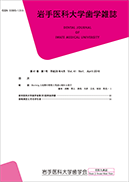Volume 15, Issue 2
Displaying 1-12 of 12 articles from this issue
- |<
- <
- 1
- >
- >|
Originals
-
1990 Volume 15 Issue 2 Pages 113-118
Published: August 30, 1990
Released on J-STAGE: November 20, 2017
Download PDF (352K) -
1990 Volume 15 Issue 2 Pages 119-127
Published: August 30, 1990
Released on J-STAGE: November 20, 2017
Download PDF (495K) -
1990 Volume 15 Issue 2 Pages 128-142
Published: August 30, 1990
Released on J-STAGE: November 20, 2017
Download PDF (731K)
-
1990 Volume 15 Issue 2 Pages 147
Published: August 30, 1990
Released on J-STAGE: November 20, 2017
Download PDF (82K) -
1990 Volume 15 Issue 2 Pages 147-148
Published: August 30, 1990
Released on J-STAGE: November 20, 2017
Download PDF (164K) -
1990 Volume 15 Issue 2 Pages 148
Published: August 30, 1990
Released on J-STAGE: November 20, 2017
Download PDF (90K) -
1990 Volume 15 Issue 2 Pages 148-149
Published: August 30, 1990
Released on J-STAGE: November 20, 2017
Download PDF (169K) -
1990 Volume 15 Issue 2 Pages 149
Published: August 30, 1990
Released on J-STAGE: November 20, 2017
Download PDF (86K) -
1990 Volume 15 Issue 2 Pages 149-150
Published: August 30, 1990
Released on J-STAGE: November 20, 2017
Download PDF (93K)
-
1990 Volume 15 Issue 2 Pages 151
Published: August 30, 1990
Released on J-STAGE: November 20, 2017
Download PDF (71K) -
1990 Volume 15 Issue 2 Pages 151
Published: August 30, 1990
Released on J-STAGE: November 20, 2017
Download PDF (71K) -
1990 Volume 15 Issue 2 Pages 151-152
Published: August 30, 1990
Released on J-STAGE: November 20, 2017
Download PDF (105K)
- |<
- <
- 1
- >
- >|
